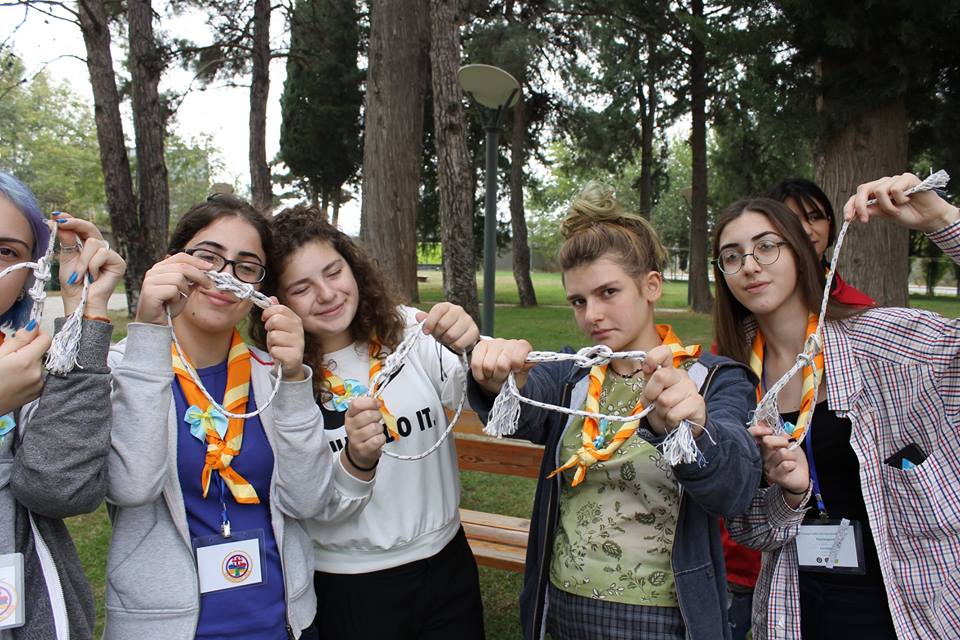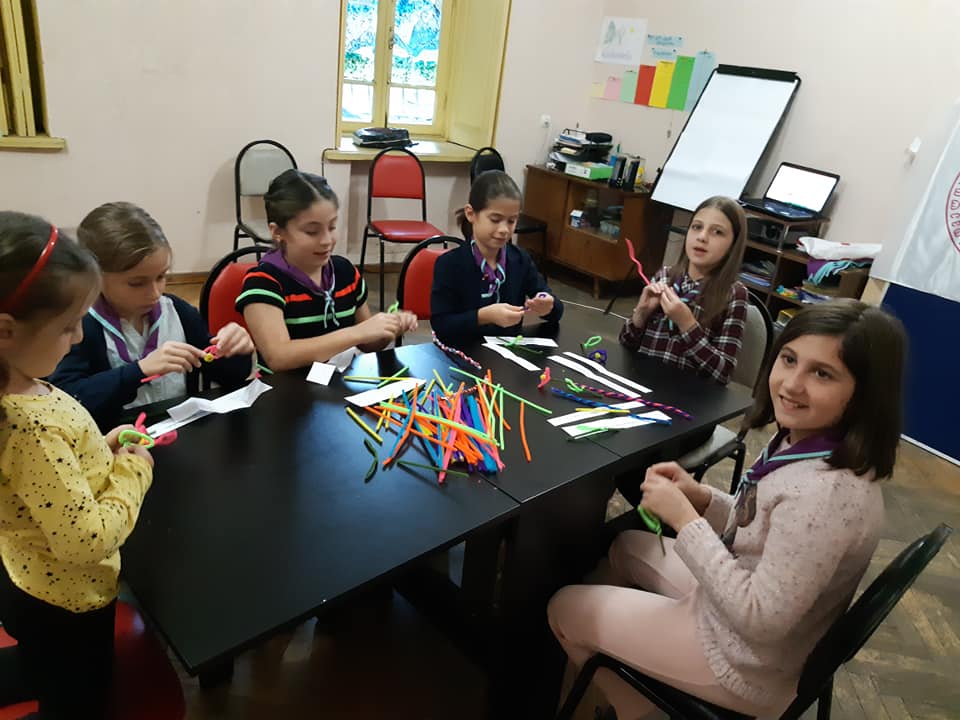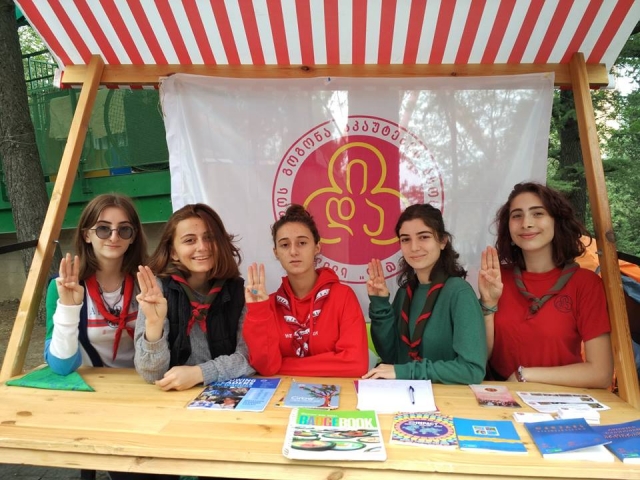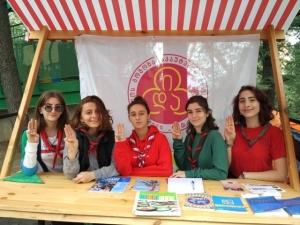Exploring the Girl Scouts of Georgia
Interview
Research shows that girls learn best in an all-girl, girl-led, and girl-friendly environment. Girl Scouts is a place where girls practice different skills, explore their potential, take on leadership positions, and even feel allowed to fail, get up, dust themselves off, and try again. Thanks to one inspiring lady, the Girl Scouts are in Georgia and growing by the year!
Kety Zhvania-Tyson is a PE Teacher, sociologist, trainer for soft skills, life-coach and landscape designer. When she’s not got her hands full with all that, she is leader of two Georgian Girl Scout groups – the Dragonflies (girls aged 11-13) and the Dia troop (girls 13-18). And she is also the country’s Girl Scout Chief Commissioner and a board member. We met her to find out more about the Georgian Girl Scouts, known as ‘Dia.’

Four members of Dia: Natuli Tsikhistavi - Young Leaders' Council, Kety Zhvania-Tyson - Chief Commissioner, Diana Maminaishvili - Training Commissioner, Tatia Gogishvili - Development Commissioner
How did Dia begin? What inspired you to start it?
In 1992, I saw a documentary about a Scout World Jamboree and instantly fell in love with the idea. At the time, I was running a youth sport group. I turned up at the very next class and announced, “we are now scouts!” But I didn't have a clue what to do, so I asked around and was introduced to Nana Bilashvili at the Ministry of Education, who had a connection with the American Girl Scouts. They put us in contact with WAGGGS (the World Association of Girl Guides & Girl Scouts). A few months later, we had a training and I became the first Girl Scout in Georgia.
I think the biggest inspiration from the first was the deep belief that my country needs this absolutely fantastic educational movement for our youth. I never stop being amazed at the wisdom and practical application behind the program and the way it helps society to develop universal human values.
Girls (and boys) in Georgia desperately need this organization to grow and succeed, so that in every city, every village of the country, children and youth who want to will be able to join.
What challenges has Dia faced? What challenges does it still face?
Three main things:
Lack of volunteers. In Georgia, there is no culture or understanding of the importance of being a volunteer. We struggle to attract women of different ages. We find students and they become great leaders, but after we train and invest in them, they soon move on, leaving us facing the same dilemma. We need to find ways to involve mothers and grandmothers for more stable troops.
We need two types of volunteers: leaders to work with the children and others to get involved in management and developing the organization. We have several committees and people can choose which one to join: Educational program development, Training for adult volunteers, International relations, Finance, Public Relations, or Development and Management.
Lack of support from officials and society. We don’t have the means to start informational campaigns even though we’re thinking about it and planning some steps for the near future.
Lack of resources. From finances to spaces for meetings and campsites. We don’t know how to fundraise. We don’t have people who know how to write grant proposals and apply to different institutions for support. We are learning, but it’s slow-going.

What values does Dia encompass?
I believe that Dia can help the young generation living in Georgia, regardless of their nationality or socio-cultural background, to develop their potential in a very humane way, to help them to acquire the knowledge, skills and attitude that will help them be happy, healthy and successful human beings.
We strongly believe that Dia supports its members to develop competencies that are recognized by the European Youth Directorate and Youth Council as crucial for young people in the 21st century.
How does it compare to other Guiding groups worldwide?
We are a very small organization, at present only associate members of WAGGGS. We’re working to get full membership. We jokingly call ourselves an “embryonic organization” but our values, methods and principles are in total alignment with the WAGGGS requirements. We use educational materials from the UK Girl Guides, American Girl Scouts, Canadian Girl Guides and Irish Girl Guides. We have a close relationship with a lot of European organizations, both of WAGGGS and WOSM (World Organization of the Scout Movement).

What activities do you do?
Dia’s educational program has seven directions:
- My personality
- Healthy lifestyle
- The outdoors
- The world of arts
- STEM
- Dia-sakhlisi (home economics, cooking, crafts, etc.)
- The world around me (about being a responsible citizen of local and global communities).
When it’s cold out, we usually work indoors due to lack of appropriate equipment for outdoor activities. We just finished a fantastic program developed by WAGGGS and DOVE “Free Being Me” about body confidence, which helps girls to get rid of the “cultural construct” about what beauty means and how we, as females, “should look.” (https://free-being-me.com/)
With my 13-18-year-old girls, I started a program about financial literacy which I got from the Girl Guides of New Zealand – it’s a great program!
In warmer weather, we have 1, 2, 3-day hikes and camping. The children have a chance to interact with nature and be in the fresh air, learning how to overcome difficulties and strengthen their character and health.
Sadly, we can’t do everything we’d like to do, due to a lack of resources and experience, but we’re trying to build every meeting on the principles of an experiential learning cycle, using a diverse methodology of non-formal education to make our meetings fun and interesting so the children have a desire to learn.

What effect has Dia had on the local community/the guides themselves?
I often hear that the girls are deeply grateful that we provide a safe space for them to be who they are, without judgment, with acceptance and love. Girls who were shy start coming out of their shells; they become more outspoken; they learn how to be leaders and work in a team; they develop a desire to be helpful to their family members, to classmates, to strangers in the street.
What are your hopes/plans for the future?
Our goals are many, but as a summary of the immediate needs, we want:
• Recognition and support from the Ministry of Education and international agencies such as UNICEF and Save the Children.
• To attract professional women to get involved in strategic planning and to work on the different committees of Dia.
• For Dia to have its own office and campsite.
• To become full members of WAGGGS.
• For Dia to have regional organizations in every region of Georgia.
• For Dia to have educational program materials developed and printed for every age group.
For more information about the Georgian Girl Scout movement, to volunteer or to help in another way, please visit: www.facebook.com/GGSDia/
You can see what the senior girl scouts say about the impact that Dia has on their lives here:
By Katie Ruth Davies












